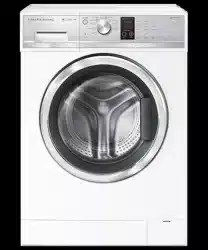Documents: Go to download!
User Manual
- User Manual - (English)
- Quick Reference guide - (English)
- Service & Warranty Booklet - (English)
- Installation Guide - (English)
USER MANUAL FRONT LOADING CLOTHES WASHER
INSTALLATION INSTRUCTIONS
Accessories
Please check you received the following accessories with your Fisher & Paykel washer. You will find them inside the drum or attached to the packaging.
- 2 x Inlet hose(s) (for models WH9060J, WH8560J, WH8060J and WH7560J only 1 x Inlet hose supplied)
- 1 x Drain hose guide
- 1 x Installation instructions and user guide
- 1 x Spanner
- 1 x Installation leaflet (attached to the top of the washer)
- 1 x Inlet valve cap (excluding WH9060J, WH8560J, WH8060J and WH7560J models)
Removing the packaging
1 Remove the outer packaging (including the polystyrene packer and plastic wrapping). All packaging must be removed prior to use. Ensure these materials are kept out of reach of children.
Note: A small amount of water may be seen inside the packaging and inside the washer. This is the result of factory testing and is normal.
2 Tilt the machine backwards and ‘walk’ it off the base one foot at a time. Not doing so may cause damage to your floor and washer.
3 Remove all packaging and accessories from inside the drum.
Removing the transit bolts
The clothes washer is fitted with 4 transit bolts at the rear to avoid damage during transportation.
The 4 transit bolts MUST be removed prior to operation of the machine. Failure to remove these will result in damage to the machine and compromise your manufacturer’s warranty
To remove the bolts:
1 Use a spanner or socket to unscrew and remove all four transit bolts at the back of the washer A.
2 Pull the black rubber grommets to remove the bolt, grommet and white plastic spacers from the machine. Keep the transit bolts in case they are required for future transit of the machine. Never transport the machine without the transit bolts properly fixed in place.
3 Cover the bolt holes with the white plastic plugs which are attached to the machine and located near each hole B. Push to clip into place.

Product dimensions

Note: The exact height of your washer is dependent on how far the feet are extended from the base of the machine. The space where you install your washer needs to be at least 40mm wider and 20mm deeper than its dimensions.
- Electrical supply: 220 – 240V, 50Hz Sinusoidal, minimum 10A.
- Inlet water static pressure: Max. 1MPa (150psi), Min. 30kPa (4.5psi).
- Inlet water flow rate at tap: Min. 6 litres/min.
Location
This machine must not be installed and operated on a plinth.
Levelling the machine
It is IMPORTANT to level the machine to ensure good spin performance, and to minimise noise, vibrations and wear and tear on the washer.
1 Before positioning the machine in its final position, check that the machine is level, front to back and side to side. 2 Manoeuvre the product into its final position (we suggest a minimum clearance of 20mm each side). 3 Use a spirit level to check that the machine is correctly level. If needed, pull the machine out. Loosen the lock nut using the spanner provided and wind the feet up or down to correctly level the machine. 4 Using the spanner provided, tighten the lock nuts against the base of the machine to lock the feet in position. | 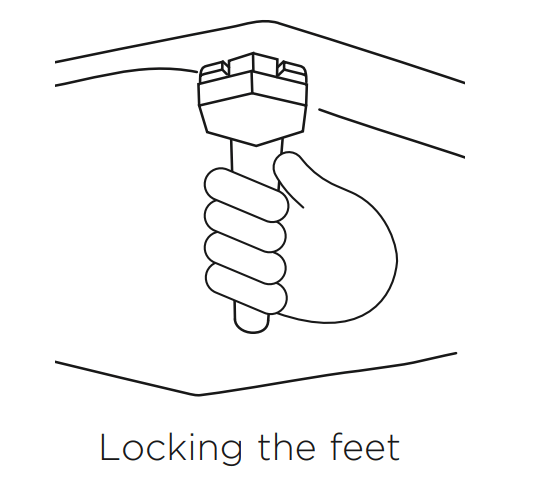 |
Connecting to the water supply
Inlet hose(s)
1 Connect the straight end(s) of the inlet hose(s) to the tap(s) and the elbow end(s) to the corresponding machine inlet valve(s). If present, the hot valve is colour coded orange. Tighten the inlet hose end(s) by hand until the hose seal just makes contact with the tap sealing face and then tighten a further half-turn. Make sure there are no kinks in the hose(s). 2 Turn the tap(s) on and check for leaks. Check for leaks again after 24 hours. | 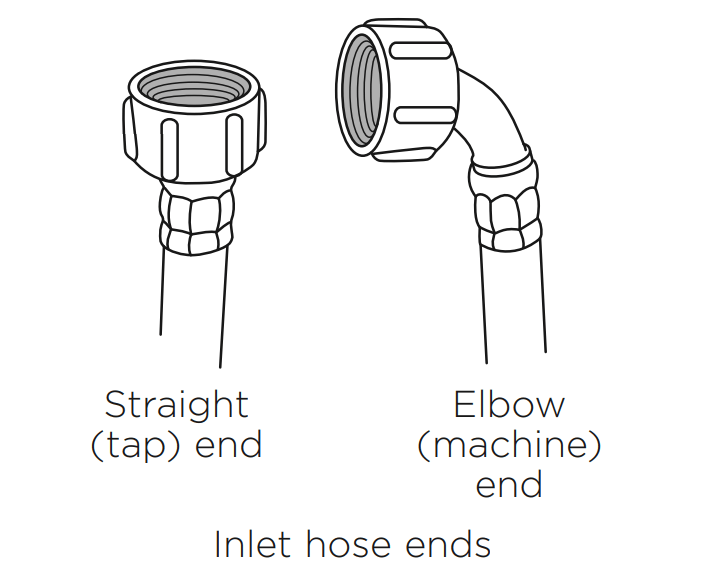 |
If you have an uncontrolled water heating source (eg a wet back or solar heating system) please contact a qualified plumber to have a Hot ‘N’ Safe Valve fitted . This will ensure the hot water temperature remains within safe limits.
CONTROL PANEL
SmartTouch™ Control Dial
The SmartTouch™ Control Dial provides easy and efficient wash cycle selection. As you rotate the dial, the icon of the wash cycle selected will be illuminated, along with the default settings for that cycle on the right side of the control panel.
SmartTouch™ buttons
The smooth, easy clean buttons enable easy selection of options with lights clearly showing the selections you are making.
Digital display screen
The digital display screen provides feedback on how long the wash cycle has to go. If you have programmed a ‘Delay Start’, the time remaining until the cycle will start will be displayed here, along with any messages to help you with the overall running of your washer (eg user warnings).
Time to go
Your washer displays approximately how many minutes the cycle you are running has remaining, so that you can tell at a glance when your washing will be finished.
Please be aware that a number of factors can influence the overall cycle time, eg the water flow rate, water pressure, whether hot water is being used from the tap or the water is heated by the internal heater, load size, cycle and option selections. Therefore cycle times will vary. Unexpected events in a wash cycle (eg out of balance, oversudsing) can lengthen the cycle time.
Progress lights
The progress lights indicate what part of the cycle the washer is currently on (wash, rinse or spin). All three lights are on at the beginning of the cycle. The light for the current part of the cycle flashes, and each one goes out when that part of the cycle is complete.
Keylock mode
Keylock can be used to lock the buttons on your washer. This will avoid accidental button pushes. For more detail please refer to ‘Wash cycle options’.
Drum light (WH8560F, WH8060F models only)
Your machine has a drum light to help assist you when loading and unloading your washing machine. When you press ‘Power’, the LED light in the drum will turn on, after 2 minutes it will automatically turn off. At the end of the cycle, the drum light will turn on again for 5 minutes to help facilitate unloading.
WH9060J, WH8560J, WH8060J and WH7560J models
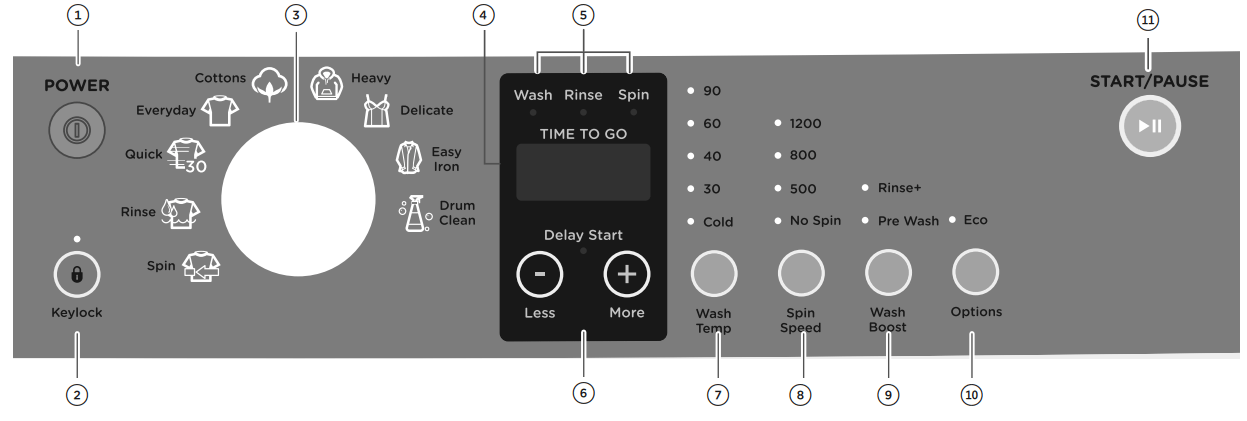
| 1 POWER | Press to turn the washer ON/OFF. |
| 2 Keylock | Touch to disable all buttons on the display panel, except the ‘Power’ button. This prevents accidental button presses. |
| 3 SmartTouch™ Control Dial | Rotate to select your desired wash cycle.
|
| 4 Digital display screen | Shows the following:
|
| 5 Progress lights | Indicate the current status of the wash cycle.
|
| 6 Delay Start | Touch to increase or decrease the delay start time. |
| 7 Wash Temp | Touch to increase or decrease wash water temperature. |
| 8 Spin Speed | Touch to increase or decrease washer spin speed. |
| 9 Wash Boost | Touch to select Pre Wash or Rinse+. |
| 10 Options | Touch to select Eco. |
| 11 START/PAUSE | Touch to start or pause the selected wash cycle. |
CARING FOR YOUR WASHER
When you have finished using your washer
- Unplug the machine from the power socket.
- Wipe around the door and in the rubber gasket to remove any remaining water and foreign matter.
- Turn off the taps to prevent the chance of flooding should a hose burst.
Cleaning your washer
Before you start cleaning your washer, ensure that it is disconnected from the power (ie unplug the machine from the power socket).
Cleaning the control panel and outer surfaces of the washer
Use a soft damp cloth to wipe all surfaces, then wipe dry. Avoid using chemical or scouring cleaners, as these will damage the paint and plastic surfaces of your washer.
Cleaning the detergent dispenser drawer
Wipe out the detergent dispenser drawer with a damp cloth. Clean it regularly, especially if you use fabric softener. To remove the drawer, pull it open, push down on the tab in the fabric softener compartment and pull out. Rinse it out under warm water and re-insert into the machine.
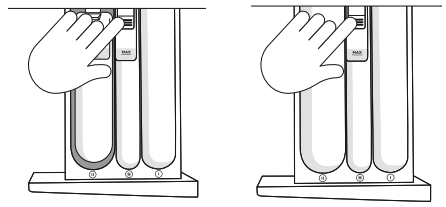
Removing the dispenser drawer for cleaning
Cleaning the inside of your washer
It is important that you regularly clean the inside of your machine using the ‘Drum Clean’ cycle. After 100 cycles  icon will flash every time you turn your washer on to remind you to do this. If your washer starts to smell this is a sign that you should complete a ‘Drum Clean’ cycle. We recommend that you do not have any items in the washer when you run this cycle. icon will flash every time you turn your washer on to remind you to do this. If your washer starts to smell this is a sign that you should complete a ‘Drum Clean’ cycle. We recommend that you do not have any items in the washer when you run this cycle. |  |
Cleaning the drum and the door
- Use a soft damp cloth to wipe the door, cleaning any water marks or residue off it.
- Wipe the rubber seal around the door. Remove any items or lint accumulating in the bottom of the seal catchment and wipe out any water accumulated here. If this is not cleaned out, unpleasant odours will develop.
- If the drum has any residual dirt or lint stuck to it, remove this and wipe the drum clean. Do not leave any metal objects in the drum as these may rust and cause staining.
- WH8560F and WH8060F models also have a self cleaning door flush that directs a portion of the rinse water over the door during various stages of the cycle to help to clean hair and insolubles from the inside of the door and surrounding parts. We still recommend that you manually clean it with a soft cloth periodically as per the instructions above.
TROUBLESHOOTING
The following is a list of problems you may encounter when using this appliance and some suggestions that may help to correct the problem. If you still have problems, please contact your Fisher & Paykel trained and supported service technician.
Operating problems
| PROBLEM | POSSIBLE CAUSES | WHAT TO DO |
| Washer does not work | Power not switched on at the wall. | Switch the power on at the wall. Then press ‘Power’. |
| Household power supply not working. | Try plugging in another electrical appliance. | |
| Keylock may be activated. | Touch and hold the ‘Keylock’ button for 2 seconds. | |
Touching  does not start the fill does not start the fill | Washer door not closed properly. | Open and reclose door |
| The washer is waiting for a command from you. | If  is flashing then the washer is waiting for a command from you is flashing then the washer is waiting for a command from you | |
| The washer has detected a fault. | Check if a code is being displayed on the panel, refer to ‘Before you call for service’. | |
| Hot and cold taps not turned on. | Check that both hot and cold taps are turned on (if using cold inlet only ensure inlet valve cap is installed on the hot valve on the machine, if present). | |
| Hot and cold taps not connected to the corresponding valve on the machine. | Check the cold tap is connected to the cold valve on the machine and the hot tap is connected to the hot valve (if present). | |
| Blocked hose filters. | Check the tap end of the inlet hose(s) for blockages. | |
| Inlet hose leaking, twisted or damaged. | Check the inlet hose for leaks or damage. Check that the inlet hose is not twisted. | |
| Faulty water supply. | Check taps that aren’t connected to the machine are working. | |
| Delay start may be set. | Refer to ‘Delay Start’ | |
| Washer stops working mid cycle | The washer has detected a fault. | Refer to ‘Fault Codes’ |
| Power or water failure. | Check the power and/or water is working correctly. | |
| Washer has been paused. | Touch the  button to continue. button to continue. | |
| Too many suds. | Washer is waiting for suds to dissolve before continuing the cycle. | |
| Washer drains while filling | Drain hose too low. | Ensure the height of the drain hose is at least 800mm from the floor level, refer to ‘Draining’. |
| Drain hose sitting in water. | Clear the drain. | |
| Washer is not draining | Drain hose blocked. | Clear the drain hose. |
| Pump filter blocked. | Clear the pump filter, refer to ‘Cleaning the pump filter’. | |
| Drain hose higher than 1200 mm above floor level. | Lower the level of the drain hose, refer to ‘Drainage’. | |
| Filling continuously | Drain hose not connected to standpipe or tub. | Connect drain hose correctly, refer to ‘Drainage’. |
| Machine siphoning. | Ensure standpipe or tub is at least 800mm from the floor level. | |
| Poor rinsing | Incorrect detergent used. | Use low sudsing, front loader detergent only, refer to ‘Detergent and Fabric Softener’. |
| Too much detergent used. | Ensure the correct dose of detergent is used for the load size and soil level, refer to ‘Detergent and Fabric Softener | |
| Not spinning properly | Load has gone out of balance. | Open door and redistribute load, then restart the washer. |
| Machine is not level. | Ensure machine is correctly levelled, refer to ‘Levelling the machine’ | |
| Suds build up. | Check the amount of detergent used, reduce if necessary | |
| Too many soap suds | Incorrect type of detergent used. | Use low sudsing, front loader detergent only, refer to ‘Detergent and Fabric Softener’. |
| Too much detergent used. | Ensure the correct dose of detergent is used for the load size and soil level. refer to ‘Detergent and Fabric Softener’. | |
| Small puddle of water from under the machine | Inlet hose or drain hose leaking. | Check inlet hose(s) and the drain hose are correctly attached and not damaged. |
| Lots of suds. | Suds may have leaked and then dissolved. | |
| Detergent dispenser blocked. | Clean detergent dispenser drawer, refer to ‘Cleaning the detergent dispenser drawer’. | |
| Detergent dispenser drawer not fully closed. | Close detergent dispenser drawer fully and ensure it remains closed during the cycle. | |
| Damage to door seal. | Check seal inside door for damage. If it sustains any damage it will need to be replaced. | |
| Cycle time longer than usual/Inaccurate time reading/Adjustment of time remaining during cycle | Wash time is approximate. | Wash time may be influenced by a number of factors, refer to ‘Time to go’. |
| Low water pressure or flow rate. | Ensure that inlet hose filters are not blocked. | |
| Out of balance or oversudsing. | Recovery from out of balance or oversudsing will extend cycle time, refer to ‘Before you call for Service’ | |
| Washing a large load. | Be aware that it will take longer for the machine to fill. | |
| Selecting various options. | Be aware that some options will extend cycle time. | |
| Detergent or fabric softener remaining in detergent dispenser at the end of the cycle | Detergent drawer not properly closed or was opened part way through the cycle. | Ensure the detergent dispenser drawer is fully closed at the start of the cycle and remains closed throughout the cycle. |
| Dirty or blocked detergent dispenser. | Clean the detergent dispenser, refer to ‘Cleaning the detergent dispenser drawer’. | |
| Liquid sitting at the ‘Max’ level at the end of the cycle indicates a blockage. | Clean the fabric softener dispenser, refer to ‘Cleaning your dispenser drawer’. | |
| Dispenser over loaded with detergent. | Clean out remaining detergent and refer to ‘Detergent and Fabric Softener’ for dosing information. | |
| Washing very wet at the end of the cycle | Cycle selected not appropriate. | Particularly short or delicate cycles have shorter spins which can result in wetter washing at the end of the cycle. |
| Incorrect spin speed for load selected. | Select a faster spin speed. | |
| An out of balance load has occurred. | The washer compensates for the out of balance by using a lower spin speed, to reduce noise and potential damage to itself. | |
| Vibrating | Transit bolts left in place. | Ensure transit bolts are removed prior to use of the machine, refer to ‘Removing your transit bolts’. |
| Washer may not be level. | Ensure washer is installed on an appropriate surface and levelled correctly, refer to ‘Levelling your machine’. | |
| Load is out of balance. | Wash an average sized load rather than a smaller load or a single item. Washing one item at a time is not recommended as it is difficult for the washer to balance a single item during spin. |
Wash problems
| PROBLEM | POSSIBLE CAUSES | WHAT TO DO |
| Poor soil Removal | Incorrect wash cycle selected. | Select a wash cycle that is appropriate for the amount of dirt, refer to ‘Wash cycle options’. |
| Insufficient detergent. | Ensure the correct dose of detergent is used for the load size and soil level, refer to ‘Detergent and fabric softener’. | |
| Washer overloaded. | Ensure the washer is not overloaded in terms of its capacity or the cycle selected, , refer to ‘Wash cycle options’. | |
| Items require a longer wash time. | Select a higher soil level option if available (WH8560P, WH8060P and WH7560P models only). | |
| Load was particularly dirty. | Select ‘Pre Wash’ for particularly dirty loads, refer to ‘Pre Wash’. | |
| Items not sorted correctly. | Wash heavily and lightly soiled garments separately | |
| Washer dirty from previous wash. | After washing particularly dirty clothing, we recommend putting the washer through a ‘Rinse’ cycle after the load has been removed, to wash away any remnants of dirt and to prevent it contaminating future washes. | |
| Incorrect wash temperature selected in relation to the type of soil. | Select a wash temperature suitable for the type of soil, eg warm for greasy soils, cold for muddy soils. Increasing the wash temperature generally improves soil removal and overall wash performance. | |
| Dye transfer | Coloured items not washed separately from white/light coloured items. | Remember to separate whites and colours |
| New or non-colourfast items not washed separately. | Wash non-colourfast items separately and select ‘Cold’ wash temperature. | |
| Wet items have been left sitting for too long. | Remove items from washer as soon as the cycle is finished, or if items are not to be removed from the washer immediately select ‘Wrinkle Free’ (WH8560F, WH8060F, WH8560P, WH8060P and WH7560P models only). | |
| Wash temperature. | Consider the wash temperature you select for your coloured items. Lower the temperature if you are concerned. | |
| Black or grey marks on clothes | Correct amount of detergent. | Ensure the correct dose of detergent is used for the load size and soil level, refer to ‘Detergent and fabric softener’. |
| Washer needs to be cleaned. | Empty the machine and complete a ‘Drum Clean’ cycle | |
| Tangling | Items not sorted correctly. | Separate larger items from smaller items. |
| Washer loaded incorrectly. | Load items loosely and individually into the washer (ie not folded). | |
| Incorrect cycle for load type selected. | Use the ‘Easy Iron’ cycle to wash shirts. | |
| Washer overloaded in terms of its capacity or the cycle selected. . | Reduce the load size | |
| Delicate items. | Wash pantyhose, bras and any other delicate items prone to tangling in a mesh laundry bag. | |
| Creasing | Washer overloaded. | Do not overload washer. |
| Incorrect cycle for load type. | Use the ‘Easy Iron’ or ‘Handwash’ cycle for creasable items. | |
| Spin speed too fast. | Select a slower spin speed. | |
| Wet clothes left in washer or laundry basket. | Laundry left sitting wet is more likely to crease. If not removing clothes from washer immediately at end of cycle, select the ‘Wrinkle Free’ option (WH8560F, WH8060F, WH8560P, WH8060P and WH7560P models only). Do not leave wet washing sitting in a washing basket. | |
| Wash temperature too hot for load type. | Select a lower wash temperature. Check items care label for correct care | |
| Items not sorted correctly. | Sort load so that items of similar weight are washed together, refer to ‘Sorting’. |
Contact a Fisher & Paykel trained and supported service technician if a problem persists.
See other models: OB76SDPTDX1 DH8060P3 TK76NDBB1 DD24DCTW9 N HP90ICSX2
